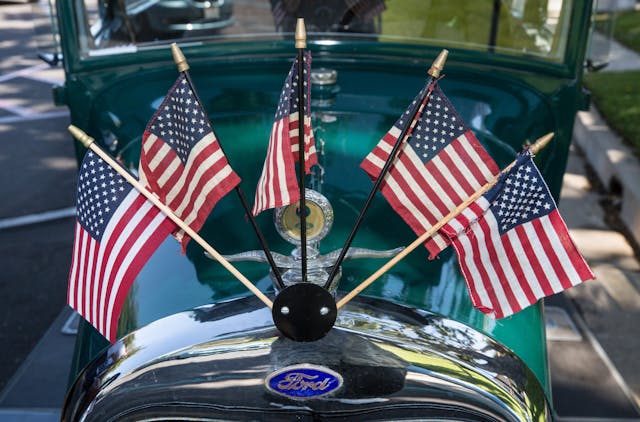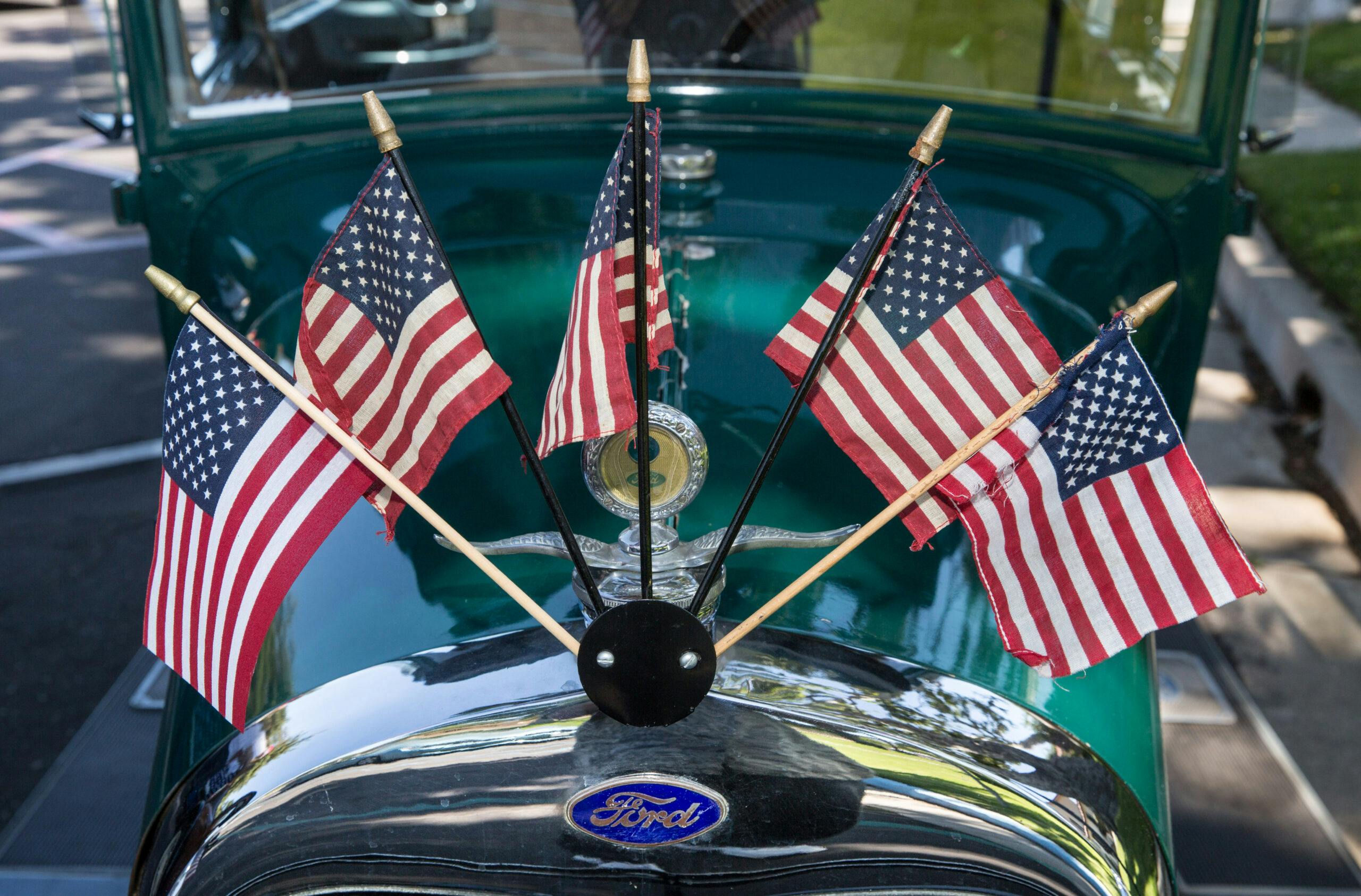Media | Articles
U.S.A. vs. The World: Domestics Dominate America’s Classic Car Enthusiasm
There are millions of collector vehicles on the road in the U.S.A. (approximately 46 million, by our count), with a collective value estimated at a trillion dollars. A lot of them weren’t built here. Indeed, imports bring a lot of variety to the hobby and to the market, be they the proverbial Lamborghini poster car, aspirational German sport sedan, the British roadster that offers cheap fun, the Japanese sport compact that offers cheap reliable fun, or the occasional French or Swedish oddball. Foreign cars understandably also get a lot of attention. For example, all of of the 30 most expensive cars ever sold at auction are foreign, and so are nine of the 10 most expensive cars in the Hagerty Price Guide. The fact remains, though, that good-old-fashioned domestic cars and trucks make up the bulk of the classic car world. We thought it was worth celebrating this time of year, and have some nice hard numbers to back it up.
If we run a popularity contest, American vehicles simply smoke everybody else. Looking at Hagerty's most insured vehicles by year/make/model, every one of the top 40 is from the US of A. Of our most insured vehicles by vehicle generation, none of the top 10 are imports, and only one of the top 20 (the 1968-80 Volkswagen Beetle) is. Only 16 of the top 100 most insured vehicle generations are foreign.
If we zoom out and look at popularity by country, it's another American blowout. Of Hagerty's insured vehicles that get driven 1000 miles or more per year, a whopping three quarters are domestic. A (very) distant second is Germany, with 12 percent.

The only area where foreign cars claw back some ground is in the auction space where, despite the muscle car-heavy mega-auctions from Mecum and Barrett-Jackson, European and Japanese vehicles sell for big money both online and at live events. That said, the vast majority of collector vehicles (about 90 percent) sell on the private market, and if we look at car count at auction instead of value, domestic vehicles still outnumber foreign vehicles, about 130,000 vs. 120,000.
So, as we roll into July 4, remember that America is still #1 when it comes to classic cars.
***
Marketplace
Buy and sell classics with confidence
Check out the Hagerty Media homepage so you don’t miss a single story, or better yet, bookmark it. To get our best stories delivered right to your inbox, subscribe to our newsletters.













Ah- Yes. .. “Celebrate the independence of your nation by blowing up a small part of it.”
American cars were part of our culture and we have had a wide verity,
Asian cars were mostly small efficient throw away cars that really were not extensions of our egos.
Many cars we collect today are cars we wished we had in the past.
The Euro cars are more expensive if we wanted one and they still are. Same with the Asian cars that we did love they were made in few numbers or were never shipped here.
So we go for the ones we can afford and we had posters of.
Never would have thought that the Po*nstar Corvette would take first place.
With as many as they built over that many years and with most still being on the road in various forms it us not hard to believe.
In 2011 I sold my ’69 “Pornstar” Corvette at auction. I was appalled that, despite the fact that it was a numbers matching 427 car with an M21 four speed and was untampered by previous owners, it sold for much less than a couple of nice ’69 Camaros that night in Monterey. My ’69 LeMans Blue on black coupe was the epitome of chrome bumper Vettes and won C3 Stock first place awards all over NorCal. While I owned it, it was insured with Hagerty.
I love that this data is actual “insured count”. I think that makes it really interesting.
The list is inconsistent though:
Mustang Generation 1 is 64.5-73, yet it is split into the refresh eras (65-66, 67-68… one has to assume 69-70, 71-73) which sure we can acknowledge that logic.
But then… no way should chrome bumper Vettes be in the same grouping as the full-glass late 70s Vettes (there goes your number 1 ranking probably) and the Camaros and Firebird/Trans Ams also have that shift to bumperless front ends in the 70s. Significant mid-cycle panel changes in all these models in those runs.
After all, that logic must have been applied to take the 79-86 Fox Bodies (four eyed) out of their generation?
And why not include all VW beetles, since it appears super beetles count. VW started selling in NA long before 68. Not in huge numbers at first, but likely enough remain as collectibles to push the Beetle into the top 10 here.
——-
What the list won’t show, because too many of them aren’t insured as classics yet, is the giant wave of Squarebody GM, GMT400 trucks, and smaller waves of every other truck/SUV that will be classically insured in the next 10-20 years. Probably a lot of Challengers/Chargers too…
——
I’d love to see these numbers broken down by decade of manufacture. Domestic product ruled sales into the 70s so kind of a foregone conclusion there. 90s and 2000s + though it will be interesting what has been kept well and what gets saved from poorer shape. I expect Lexus for example will be statistically relevant, and there is a lot of performance luxury models in the last 20 years… so compare attrition rates of 50’s Cadillac models and 60s Impalas for example and we might find that certain Toyotas and BMW have a higher survival rate than many of the current favourites.
I’m surprised that 73-79 Ford trucks even made the top 20 at #19, and even more surprised that the 47-55 Chevy trucks is only at #20!
I am surprised. No accounting for taste.
I presently own a ’69 Mustang convertible which Hagerty has insured for the 26 years I’ve owned it. I was surprised that the 69-70 and 71-73 first gen Mustangs didn’t appear in the top 20. I also have a ’95 Bronco XLT and, while some other trucks made the list, neither did my Bronco. The full sized Bronco market is pretty hot right now. You also didn’t include my C6 Corvette. I am hurt.
Foreign cars have always had the snob appeal even back in the 60’s-80’s! Check out any car review from other than Hot Rod or the likes, the foreign cars were”always better than American made cars”. I won a 1967 Camaro and a 1968 Chevrolet SS427 Impala both bought new by my wife and I. Not surprised that the list didn’t include SS427 full size cars since Chevrolet wanted to sell Chevelles and didn’t push for the bigger car that made less profit. It always surprised the Z28 and Firebird 400s when I would beat them, or the 396 Chevelle that thought he could outrun me on the freeway coming back from Willow Springs.
Forty something years ago I bought my first car, an import, that is now a “collectible”. Back in the 70’s foreign parts, hardware, another set of metric tools and specialty mechanics were few and far just adding to the expenses. The oil embargo didn’t hurt but everything else did wreak havoc on the velcro billfold and put a down payment on a used base ‘73 Pontiac Ventura.
Fast forward into the 21st Century and I had bought my second “import”…another collectible. Parts are plenty, specialty mechanics so-so but both just as expensive comparatively to yesteryear and still a wait-in-line for service and mail order parts.
I used to wait to get paid to have a car fixed, now I wait to get the parts or wait to get a mechanic just for an estimate and another date to fix whatever they find.
So looking over the list perhaps, I’ll sooner not later find the ideal domestic, where I can walk into any local auto parts store and get parts and fluids right off the shelf instead of succumbing to porch pirates glomming my web order, or get on a two month waiting list for an troubleshooting issue and oil service.
Is it a shocker that the home country’s vehicles lead the collector’s list in said country? Not at all. More of them to have to start and therefore more to survive the years.
Very shocked that not one GTO is mentioned in the list. Very surprising and almost looks like there is “missing” data? Or are they all insured by another company? The list is somewhat “skewed” as not all classic vehicles are listed with one insurer.
These results can likely be partially a result of the aftermarket support for many American vehicles being very good. To restore a Model A or 50s to 70s Chevy is light years easier than a vintage import with the exception of the Beetles. More parts equal an easier and more cost and time effective restoration. I used to sell vintage auto parts. I always felt bad having to inform an enthusiastic new customer that the ’49 Kaiser or ’72 Rover he just purchased was not well supported by the aftermarket. A few newcomers to the hobby looked at the wall displayed with Vintage Ford and Tri-five Chevy stuff and passed the Kaiser along to someone more experienced and bought a ’56 Chevy Belair. Many of those popular cars in this list have very good aftermarket support. More support, more customers.